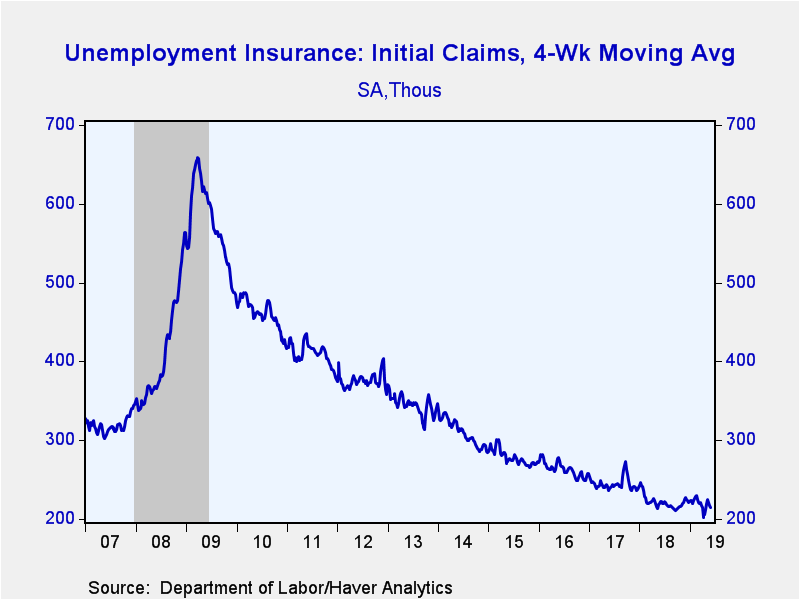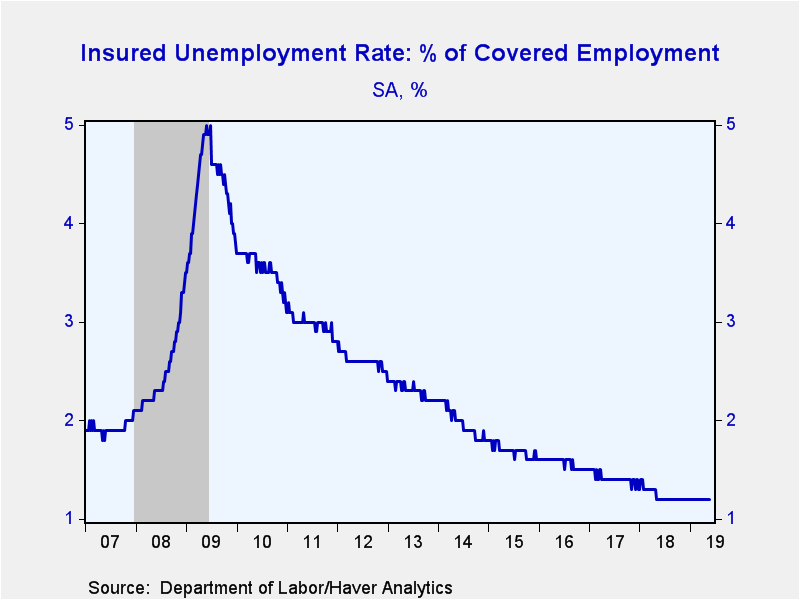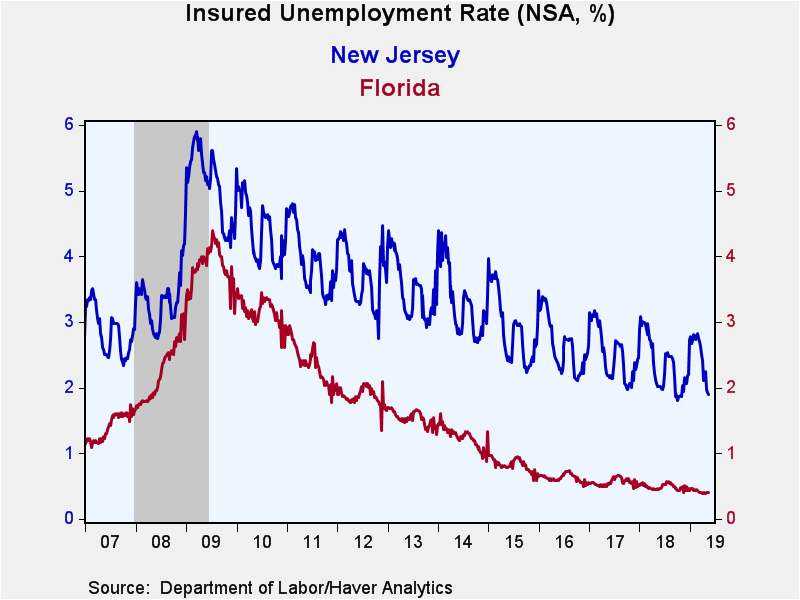 Global| Jun 06 2019
Global| Jun 06 2019U.S. Initial Unemployment Insurance Claims Unchanged
by:Sandy Batten
|in:Economy in Brief
Summary
The labor market remains historically quite robust. Initial claims for unemployment insurance were unchanged at 218,000 in week ended June 1 (the previous week’s reading was revised up slightly from 215,000) and remain around their [...]
The labor market remains historically quite robust. Initial claims for unemployment insurance were unchanged at 218,000 in week ended June 1 (the previous week’s reading was revised up slightly from 215,000) and remain around their lowest level in nearly six decades. The latest reading was slightly higher than the 215,000 expected by the Action Economics Forecast Survey. The four-week moving average of initial claims fell to 215,000 from 217,500 in the previous week.
Continuing claims for unemployment insurance rose 20,000 to 1.682 million in the week ending May 25. The four-week moving average of claimants declined 1,000 to 1.673 million.
The insured rate of unemployment remained at the record low of 1.2% in the week ending May 25, where it's been for twelve months. The series dates back to 1970.
Given the high frequency of the claims data, they will surely be looked to for any indication that the recent escalation in trade tensions is adversely impacting the labor market. US-China tensions began to re-escalate in early May. Thus far, claims have not seemed to be much affected. The possibility of tariffs on goods imported from Mexico did not emerge until early June and so it is too soon to expect to see any impact on the labor market.
Insured rates of unemployment vary widely by state. In the week ending May 18, the lowest rates were in South Dakota (0.25%), Nebraska (0.33%), Florida (0.40%), North Carolina (0.44%), Indiana (0.44%) and North Dakota (0.44%). The highest rates were in Puerto Rico (1.68%), Connecticut (1.72%), California (1.87%), New Jersey (1.90%) and Alaska (2.16%). Among the other largest states by population, the rate was 0.94% in Texas, 1.20% in New York and 1.43% in Illinois. These state data are not seasonally adjusted.
Data on weekly unemployment claims going back to 1967 are contained in Haver’s WEEKLY database, and they are summarized monthly in USECON. Data for individual states are in REGIONW. The expectations figure is in the AS1REPNA database.
| Unemployment Insurance (SA, 000s) | 06/01/19 | 05/25/19 | 05/18/19 | Y/Y % | 2018 | 2017 | 2016 |
|---|---|---|---|---|---|---|---|
| Initial Claims | 218 | 218 | 212 | -0.9 | 220 | 244 | 262 |
| Continuing Claims | -- | 1,682 | 1,662 | -3.8 | 1,756 | 1,961 | 2,135 |
| Insured Unemployment Rate (%) | -- | 1.2 | 1.2 |
1.2 |
1.2 | 1.4 | 1.6 |
Sandy Batten
AuthorMore in Author Profile »Sandy Batten has more than 30 years of experience analyzing industrial economies and financial markets and a wide range of experience across the financial services sector, government, and academia. Before joining Haver Analytics, Sandy was a Vice President and Senior Economist at Citibank; Senior Credit Market Analyst at CDC Investment Management, Managing Director at Bear Stearns, and Executive Director at JPMorgan. In 2008, Sandy was named the most accurate US forecaster by the National Association for Business Economics. He is a member of the New York Forecasters Club, NABE, and the American Economic Association. Prior to his time in the financial services sector, Sandy was a Research Officer at the Federal Reserve Bank of St. Louis, Senior Staff Economist on the President’s Council of Economic Advisors, Deputy Assistant Secretary for Economic Policy at the US Treasury, and Economist at the International Monetary Fund. Sandy has taught economics at St. Louis University, Denison University, and Muskingun College. He has published numerous peer-reviewed articles in a wide range of academic publications. He has a B.A. in economics from the University of Richmond and a M.A. and Ph.D. in economics from The Ohio State University.










